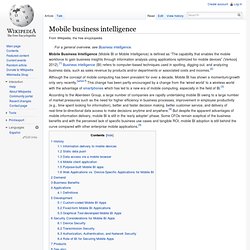

Mobile business intelligence. Mobile Business Intelligence (Mobile BI or Mobile Intelligence) is defined as “The capability that enables the mobile workforce to gain business insights through information analysis using applications optimized for mobile devices” (Verkooij 2012).[1] Business intelligence (BI) refers to computer-based techniques used in spotting, digging-out, and analyzing business data, such as sales revenue by products and/or departments or associated costs and incomes.[2] Although the concept of mobile computing has been prevalent for over a decade, Mobile BI has shown a momentum/growth only very recently.

[when?] This change has been partly encouraged by a change from the ‘wired world’ to a wireless world with the advantage of smartphones which has led to a new era of mobile computing, especially in the field of BI.[3] History[edit] Business intelligence. Business intelligence (BI) is the set of techniques and tools for the transformation of raw data into meaningful and useful information for business analysis purposes.

BI technologies are capable of handling large amounts of unstructured data to help identify, develop and otherwise create new strategic business opportunities. The goal of BI is to allow for the easy interpretation of these large volumes of data. Identifying new opportunities and implementing an effective strategy based on insights can provide businesses with a competitive market advantage and long-term stability.[1] BI technologies provide historical, current and predictive views of business operations. How to Build a BI Solution. This chapter provides two scenarios to show you how to craft a business intelligence system.

There is one scenario for each query and analysis tool and for each type of data store, as described in Chapter 1. Implementing a Business Intelligence Solution This chapter describes two fictitious companies, with two different data sets and two different sets of requirements. It presents an Oracle business intelligence solution for each one, using a unique combination of the tools described in Chapter 1.
The Global example is based on the Global schema, which is available on the Oracle Business Intelligence Web site at.